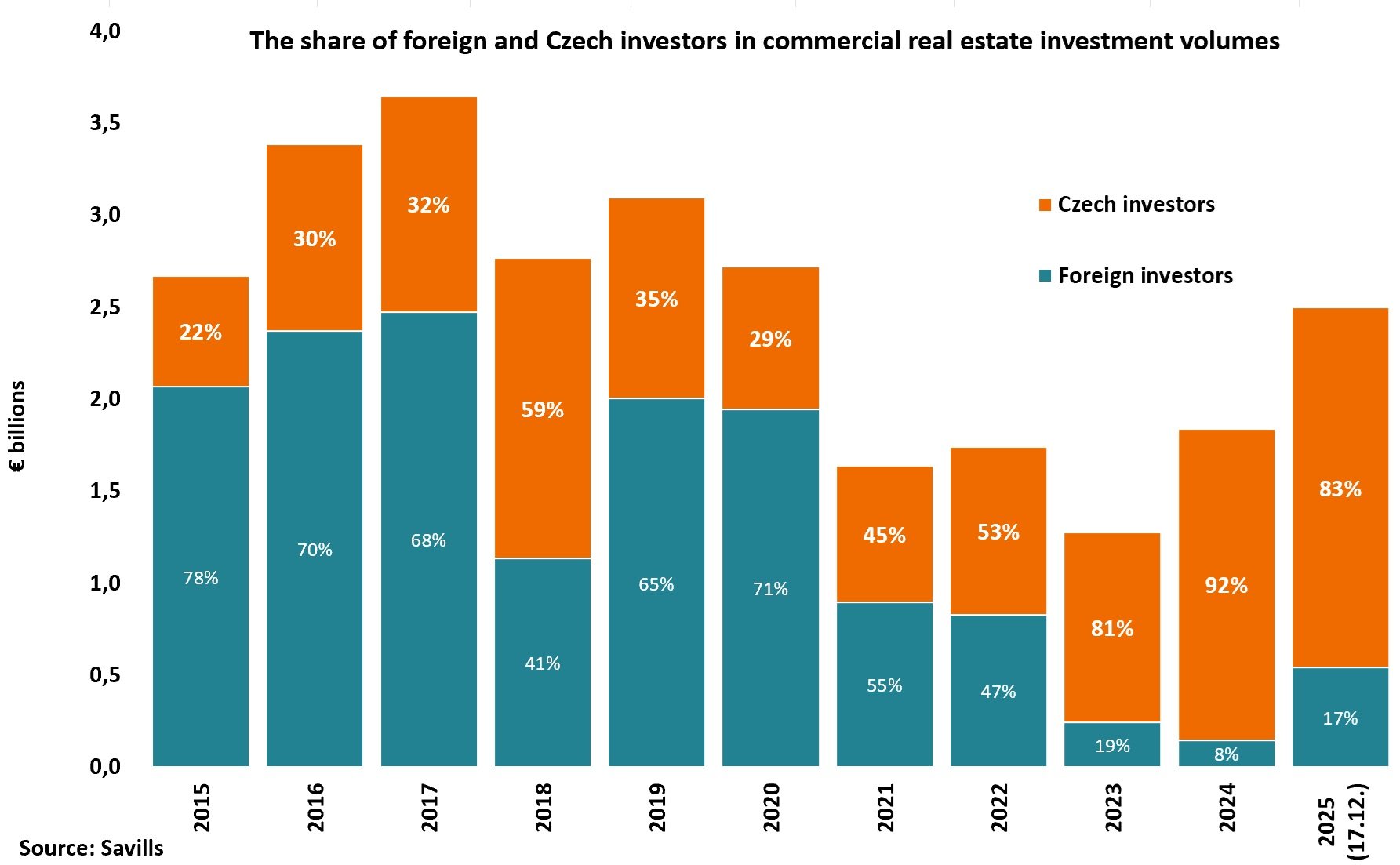The latest report by advisory firm Savills Poland, “Investment Market in Poland H1 2025”, shows that after a moderate start to the year, the second quarter brought a revival in Poland’s real estate investment market. Although total transaction volume remains below the post-2020 average, investors are returning – cautiously, selectively, and increasingly from the CEE region. Logistics remains the leading sector, accounting for nearly half of all transaction value. Value-add strategies are also gaining momentum, offering potential for increased asset value through redevelopment, modernisation, or repurposing.
ECONOMIC STABILIZATION AND INTEREST RATE CUTS BENEFIT INVESTORS
Poland’s economy continues to grow steadily, with GDP forecasted to rise by 3.4 percent in 2025 and 3.2 percent in 2026. Growth remains driven by private consumption, supported by rising real household incomes. After a temporary dip in foreign direct investment in 2024 (to approx. USD 12.74 billion from USD 28.36 billion the previous year), investment activity is expected to accelerate, fueled in part by EU funds and export recovery.
The financial market continues to shift toward a looser monetary policy. In May, the reference rate was cut by 50 basis points, followed by another 25-point cut in July, bringing the rate to 5.0 percent. Further reductions are likely amid stabilising inflation (3.6 percent in 2024, with a forecast of 3.9 percent) and a positive macroeconomic outlook. The European Central Bank began cutting rates in February, with the most recent cut in June bringing the refinancing rate to 2.15 percent. Lower financing costs are expected to increase market liquidity and investor activity in real estate.
“The investment market is stabilising, and investor activity is gradually increasing. Alongside capital seeking long-term, stable assets, we’re also seeing growing interest in projects with redevelopment, repositioning, or conversion potential,” said Mark Richardson, Head of Investment, Savills Poland
SELECTIVE RECOVERY WITH LOGISTICS LEADING THE WAY
In Q2 2025, investment transactions in Poland’s real estate market totaled €911 million – up 45 percent quarter-on-quarter but down 33 percent year-on-year. Total H1 2025 volume reached €1.53 billion, a 10 percent decrease year-on-year. Growth in Q2 was driven primarily by the logistics sector, with the largest transaction being the sale of two Eko-Okna manufacturing plants for over €253 million.
Office investment reached €227 million in Q2 (and €411 million for H1), still 50 percent below the previous year. Retail investment dropped by 30 percent, with €133 million in Q2 and €324 million for the half-year, 26 percent below the 2020–2025 average. This reflects ongoing challenges in the retail sector, with increasing investor focus on smaller retail parks and convenience formats.
Although H1 2025’s total investment volume represented only one-third of 2024’s full-year value, transaction volume was strong – 59 deals were signed, equaling 48 percent of last year’s total. Most were small-scale transactions, with an average deal size of €26 million. Only one deal exceeded €100 million – the Eko-Okna transaction.
US investors led the market with a 31 percent share, followed by Western and Nordic European countries (20 percent). Investors from CEE (including Ukraine) made up nearly 37 percent, making the region the top source of capital.
“The first half of 2025 saw strong activity from regional and domestic investors, particularly in smaller-scale transactions. Sale & leaseback deals, like Eko-Okna’s, and a return to value-add strategies show investors are more willing to engage with complex, but promising projects. The market is becoming more diverse and mature,” said Wioleta Wojtczak, Associate Director, Head of Research, Savills Poland
OFFICES RETURNING CAUTIOUSLY
From January to June, 23 office investment deals were concluded, totalling over €411 million – 52 percent of 2024’s deal count but only 25 percent of its value. This indicates growing activity but smaller average deal sizes. The average office transaction was valued at €18 million – €8 million less than the average for single-building transactions last year.
Capital was deployed both in Warsaw and regional cities. Three of the five largest deals involved Warsaw properties; the others were in Kraków, Wrocław, and Szczecin. Foreign investors (e.g., Uniqa Real Estate, Stena Real Estate) led the largest deals, while domestic investors accounted for 42 percent of disclosed capital.
Prime office yields in central Warsaw are estimated at around 6.00 percent. Yields for top assets in non-central or regional locations are 125–150 basis points higher.
RETAIL FOCUSED ON SMALL FORMATS
The retail market saw 20 deals totalling €324.4 million. The average deal value was just over €16 million, highlighting investor preference for smaller projects like retail parks and convenience centres, which accounted for half of all transactions. Three deals involved portfolios, including Czech group Reticulum’s acquisition of 10 A-Centrum properties. Other deals involved vacant assets with redevelopment potential, such as Arkady Wrocławskie, which will be demolished and redeveloped into a mixed-use project by Vastint.
Domestic investors were responsible for nine transactions (25 percent of sector volume). Despite only four deals, capital from Czechia and Ukraine accounted for 39 percent of retail investment volume. More deals are expected in H2, including regional shopping centres.
Prime yields for top shopping centres are estimated at 6.25–6.50 percent, though best-in-class properties may yield less. Retail park yields range between 7–8 percent, depending on location, competition, and tenant quality.
RECORD LOGISTICS AND INDUSTRIAL VOLUMES
The logistics sector accounted for 45 percent of total investment volume in H1 2025, with 12 transactions totalling €694 million – nearly 2.5x higher than the same period last year. This surge was led by the Eko-Okna deal (over 36 percent of the sector’s volume) and Adventum Industrial’s acquisition of a four-property portfolio.
Investors are increasingly selective, favouring stable assets with long leases (WAULTs exceeding 10 years). US investors dominated, contributing 64 percent of logistics capital, far ahead of Czech (12.5 percent) and Hungarian (10.2 percent) investors.
Prime yields for logistics assets remain stable at 6.25–6.50 percent. Further interest rate cuts are expected to reduce financing costs and may boost investor activity in this segment.
LIVING SECTOR: NICHE BUT GROWING
The institutional living sector remains small compared to traditional commercial markets. Only three transactions were recorded in H1 2025, totalling €86.5 million. Two involved student housing properties in Warsaw and Wrocław, purchased by Belgium’s Xior. The third was a PRS project in Kraków by Eiffage Immobilier Polska and LifeSpot Management.
“The living sector is still a niche, but gaining visibility. The activity of players like Xior and LifeSpot – also in regional cities – shows growing international interest. Demographics, migration, and lifestyle changes among the younger generation will drive growth in this segment,” said Jacek Kałużny, Director, Head of Operational Capital Markets, Savills
Despite small volumes, Savills experts believe the sector is gaining strategic importance. Media reports indicate TAG Immobilien is in talks to acquire part of Resi4Rent’s portfolio – the largest institutional rental housing operator in Poland. If completed, this would mark a significant milestone for the PRS segment, confirming market liquidity and building investor confidence by demonstrating viable exit routes beyond individual sales.
Prime yields are estimated at around 6 percent for PBSA (student accommodation), and 5.5 percent for PRS on residential land, rising to approx. 6 percent for commercial sites.







